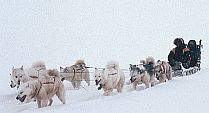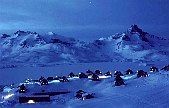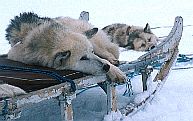x
Greenland
 When winter freezes the sea around Greenland, dog teams keep people moving. Here's a look at this way of life. Greenland's flag, right, symbolises the red midnight sun and the white ice.
When winter freezes the sea around Greenland, dog teams keep people moving. Here's a look at this way of life. Greenland's flag, right, symbolises the red midnight sun and the white ice.
Note: this article was written in 1994.
Born to run
"Do not pat or feed the dogs, and make sure you are on your sled when the first team sets off." These were the instructions as we approached our dog sleds. It was good advice; as soon as one team is away it is difficult to hold back the others and nine sleds were soon out on the frozen fjord.
 We had set out from Ammassalik, the main town on Greenland's east coast. Our drivers were local hunters diversifying from their usual work. It makes sense: for someone wanting a payload, willing travellers are a better bet than unwilling seals.
We had set out from Ammassalik, the main town on Greenland's east coast. Our drivers were local hunters diversifying from their usual work. It makes sense: for someone wanting a payload, willing travellers are a better bet than unwilling seals.
White world
Before long, low cloud obliterated the mountain tops to both sides and it started to snow. It was a completely white world and the only discernible shapes were the sleds immediately in front and behind. The brochure had said something about crystal clear weather in April but no one was bothered — this was the real Arctic.
April is actually an ideal time to visit Ammassalik. There is plenty of daylight and the long hard winter begins to relax its grip. The weather is unpredictable but its variety enhances the experience of travel at these latitudes. Even so, we appreciated the blue skies and sunshine when they came later!
 The trip lasted only a few hours but was good preparation for forthcoming longer journeys. It provided an opportunity to work out how many layers of clothing to wear. The answer was all of them.
The trip lasted only a few hours but was good preparation for forthcoming longer journeys. It provided an opportunity to work out how many layers of clothing to wear. The answer was all of them.
The temperature is usually below zero, but keeping warm is not a problem as it is easy to get off the sled on an uphill stretch and walk for a while. This pleases the dogs but not always the hunters, who have great pride in their teams and want to show off the dogs' strength, especially when other hunters are present.
While walking up a hill and firmly holding onto one of the sled's stanchions, I realised just how strong the dogs are. Even with the sled still carrying the driver plus baggage, it is often a struggle to keep up. Letting go of the stanchion is not a good idea, nor is being off the sled when the dogs reach the level.
Inuit culture
Ammassalik is one of two inhabited areas on Greenland's east coast. It is a modern town with 1500 people living there, plus another 1300 in six villages in adjacent fjords. Before Europeans arrived a hundred years ago, Inuit people had lived in the area for centuries. Their culture still plays an important role in everyday life, with hunting and fishing in the fjords being vital to the economy.
 However, Ammassalik's change from Stone Age to Space Age is accelerating. Glass fibre dinghies have replaced kayaks, rifles have replaced harpoons, and synthetic clothing has replaced polar bear skins. And now there are increasing numbers of skidoos and satellite dishes. Despite these changes, dogs are seen outside many houses, and dog sleds are still the most important mode of transport.
However, Ammassalik's change from Stone Age to Space Age is accelerating. Glass fibre dinghies have replaced kayaks, rifles have replaced harpoons, and synthetic clothing has replaced polar bear skins. And now there are increasing numbers of skidoos and satellite dishes. Despite these changes, dogs are seen outside many houses, and dog sleds are still the most important mode of transport.
Frozen waterfall
Our next dog-sled trip took us to Ikkatteq, a settlement of seven families who live by seal hunting and fishing. Along the route there was a frozen, snow-covered waterfall to negotiate and it proved interesting in both directions.
After finally reaching the top on the return journey, humans and dogs took a breather. The humans had a drink and a biscuit, and admired the view across the fjord to Greenland's main icecap, which is two miles thick in parts. Some dogs still had enough energy for fighting and amorous adventures. Others lay down and dozed, not due to tiredness, but because it is part of their training — if they do not stay down on hunting trips, they scare off the prey.
 In the past, seal hunting was the means of survival for the Inuit, supplying meat for food and fur for warmth. More recently it was the mainstay of Greenland's economy and, although now less important to the country as a whole, it is still a livelihood for many people on the east coast.
In the past, seal hunting was the means of survival for the Inuit, supplying meat for food and fur for warmth. More recently it was the mainstay of Greenland's economy and, although now less important to the country as a whole, it is still a livelihood for many people on the east coast.
Seal meat remains an essential food, but in modern Greenland the hide is no longer needed for kayak coverings or cabin insulation. This enables hunters to sell surplus hides for clothing. But despite using traditional hunting methods and taking only what they need, Greenland's hunters have suffered from the international backlash to the commercial hunting of young harp seals off Newfoundland. Appropriately, growing revenue from visitors is starting to redress this injustice.
Tiniteqilaaq is another village that depends on hunting and fishing. It lies on the next fjord and is a full day's journey by dog sled from Ammassalik. The first part of the route took us through mountain valleys, followed by a climb to the top of the Asingaleq glacier, from where we made a rapid descent to the village nestling by a misty fjord.
Trapped icebergs
The local schoolhouse provided overnight accommodation, and next morning we watched the mist lift to reveal the frozen fjord. Icebergs from the calving glaciers at the head of the fjord, trapped since the start of winter, were waiting to be freed.
A dog team usually contains between six and twelve dogs. In west Greenland, where it is flat, dogs work in a fan formation with all ropes the same length. In east Greenland's mountainous terrain, dogs must pull straight ahead and they work in pairs, though they often spread out if the going is easy.
It is mostly hunters who have dog teams, but some people keep dogs for sport and recreation. I learned more about the dogs from Peter, a Dane who moved to Ammassalik in 1984 and now hunts with his dog team in winter.
Born leaders
Drivers continually shout instructions, and all dogs are trained to obey four commands: go forwards or faster, pull, stop, and lie down. By calling a dog's name, a driver can give an instruction to an individual dog, especially useful for dogs that are smart enough to tighten the rope without actually pulling.
Two extra commands, go left and go right, are for the lead dog only. Some dogs are born leaders. "One dog immediately understood left and right, and it tangled up the ropes on the sledge," said Peter. "I had to put this dog just behind the leader."
 Hunters usually breed their own dogs. But if anyone is short of dogs, through disease for example, others will help him out. Training takes about two months and Peter starts a dog when it is six months old: "I put the dog in with a team, at the back near the sled. Some pull straight away. If not, I let the dog run for a while before moving it forward to stretch the line. When a young dog gets tired, I untie it to run alongside the sled."
Hunters usually breed their own dogs. But if anyone is short of dogs, through disease for example, others will help him out. Training takes about two months and Peter starts a dog when it is six months old: "I put the dog in with a team, at the back near the sled. Some pull straight away. If not, I let the dog run for a while before moving it forward to stretch the line. When a young dog gets tired, I untie it to run alongside the sled."
I wondered if skidoos would ever replace dogs for hunting. "Never!" said Peter. "Dog sleds can go out in December, two months before the ice is thick enough to support skidoos. And skidoos make much more noise, so they could drive the seals away." For this reason, Ammassalik has strict laws that prohibit skidoos from going into hunting areas. Besides, dogs are preferable for long trips because they do not have engine problems or run out of fuel. When tracks are hard at the end of April, a dog team can travel over ninety miles in a day.
Pride in the national costume
Before the Europeans arrived, men hunted to supply food, and women sewed to provide clothing. Even though synthetic garments are now readily available, traditional sewing skills are still apparent in the national costume worn by girls and women on festive occasions. Peter's daughter, Tikâjât, showed me her costume. The trousers feature millimetre-sized pieces of seal skin sewn in delightful patterns. Most conspicuous is the large multi-coloured collar, sewn from many tiny beads.
 Traditionally, a girl is given her first costume for her first school day, a new one for her Confirmation, and another when fully grown. But it's getting expensive these days. And very time-consuming for those who make the costumes, with a collar typically taking a month of evenings. Even so, the national costume is Greenland's pride and joy and nationwide competitions are now held to find the best.
Traditionally, a girl is given her first costume for her first school day, a new one for her Confirmation, and another when fully grown. But it's getting expensive these days. And very time-consuming for those who make the costumes, with a collar typically taking a month of evenings. Even so, the national costume is Greenland's pride and joy and nationwide competitions are now held to find the best.
Light show
The view from Ammassalik's hotel is like looking down on an amphitheatre. The fjord has only a small inlet at one end and appears to be a lake, frozen solid and containing trapped icebergs. On the far side, triangular mountains reach for the sky. The town itself lies on the hillside below the hotel. A theatrical analogy is entirely appropriate because on a clear evening there is free admission to a marvellous light show in three acts.
First, as the sun drops out of sight, there is alpenglow on the peaks of the mountains. Then, as daylight fades, the town's electric lights are gradually switched on, becoming more prominent as the sky finally turns to black. Up to this point, it is possible to watch from the hotel bar but you definitely need to go outside for the finale — the Northern Lights. Continually changing shape, yellow curtains of light pulse across the sky. They seem to unsettle the dogs: one starts howling, then another, and before long all the dogs in town are howling.
The sights and sounds of the Arctic — they remain with you long after you leave.
x